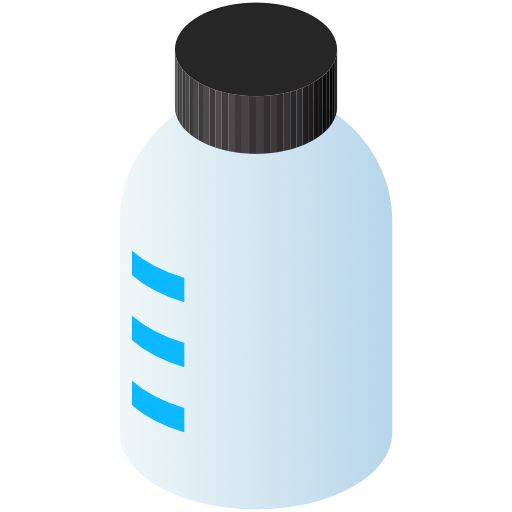Similar packages
Felimazole
Active substance
ATC code
Species
Cats
Indications
For the stabilisation of hyperthyroidism prior to surgical thyroidectomy. For the long-term treatment of feline hyperthyroidism.
Dose to be administered and administration route
Oral use.
For the stabilisation of feline hyperthyroidism prior to surgical thyroidectomy and for the long-term treatment of feline hyperthyroidism, the recommended starting dose is 5 mg per day (1 ml of the veterinary medicinal product).
Wherever possible, the total daily dose should be divided into two equal doses and administered morning and evening.
If, for reasons of compliance, once daily dosing is preferable, then this is acceptable, although the twice-daily dose may be more efficacious in the short term.
In order to administer the dose accurately, use the syringe provided in the package. The syringe fits on the bottle and is graduated in 0.25 mg increments up to 5 mg. Withdraw the required dose and administer the veterinary medicinal product directly into the cat’s mouth.
Haematology, biochemistry and serum total T4 should be assessed before initiating treatment and after 3 weeks, 6 weeks, 10 weeks, 20 weeks, and thereafter every 3 months. At each of the recommended monitoring intervals, the dose should be titrated to effect according to the total T4 and to clinical response to treatment. Dose adjustments should be made in increments of 2.5 mg (0.5 ml of the veterinary medicinal product) and the aim should be to achieve the lowest possible dose rate. In cats that require particularly small dose adjustments, increments of 1.25 mg of thiamazole (0.25 ml of the veterinary medicinal product) can be used.
If more than 10 mg per day is required (2 ml of the veterinary medicinal product) animals should be monitored particularly carefully.
The dose administered should not exceed 20 mg/day (4 ml of the veterinary medicinal product).
For long-term treatment of hyperthyroidism, the animal should be treated for life.
Adverse reactions
Adverse reactions have been reported following long-term control of hyperthyroidism. In many cases signs may be mild and transitory and not a reason for withdrawal of treatment. The more serious effects are mainly reversible when medication is stopped and, in these cases, treatment should be stopped immediately and alternative therapy considered, following a suitable period for recovery.
Uncommon (1 to 10 animals / 1,000 animals treated): | Vomiting[1], Anorexia1, Inappetence1, Lethargy1 Pruritus1,[2], Excoriation1,2 Prolonged bleeding1,[3],[4] Icterus1,4, Hepatopathy1 Eosinophilia1, Lymphocytosis1, Neutropenia1, Lymphopenia1, Leucopenia1 (slight), Agranulocytosis1 Thrombocytopenia1,[5],6, Haemolytic anaemia1 |
Rare (1 to 10 animals / 10,000 animals treated): | Autoimmune disorder (serum anti-nuclear antibodies) |
Very rare (<1 animal / 10,000 animals treated, including isolated reports): | Lymphadenopathy5, Anaemia5 |
6 Occurs uncommonly as a haematological abnormality and rarely as an immunological side effect.
Following long-term treatment with thiamazole in rodents, an increased risk of neoplasia in the thyroid gland has been shown to occur, but no evidence is available in cats.
Reporting adverse events is important. It allows continuous safety monitoring of a veterinary medicinal product. Reports should be sent, preferably via a veterinarian, to either the marketing authorisation holder, or its local representative, or the national competent authority via the national reporting system. See the package leaflet for respective contact details.
Dispensing
POM-V - Prescription Only Medicine – VeterinarianSUMMARY OF PRODUCT CHARACTERISTICS
1. NAME OF THE VETERINARY MEDICINAL PRODUCT
Felimazole 5 mg/ml Oral Solution for Cats
2. QUALITATIVE AND QUANTITATIVE COMPOSITION
Each 1 ml dose contains
Active substance:
Thiamazole 5 mg
Excipients:
|
Methyl parahydroxybenzoate |
2.00 mg |
|
Propyl parahydroxybenzoate |
0.20 mg |
3. PHARMACEUTICAL FORM
Oral Solution
Clear, light yellow to yellowish-brown solution.
4. CLINICAL PARTICULARS
4.1 Target species
Cats
4.2 Indications for use, specifying the target species
For the stabilisation of hyperthyroidism prior to surgical thyroidectomy. For the long-term treatment of feline hyperthyroidism.
4.3 Contraindications
Do not use in cats suffering from systemic disease such as primary liver disease or diabetes mellitus.
Do not use in cats showing signs of autoimmune disease.
Do not use in animals with disorders of white blood cells, such as neutropenia and lymphopenia.
Do not use in animals with platelet disorders and coagulopathies (particularly thrombocytopenia).
Do not use in pregnant or lactating females.
Do not use in cases of hypersensitivity to the active substance or to any of the excipients.
Please refer to section 4.7.
4.4 Special warnings for each target species
In order to enhance stabilisation of the hyperthyroid patient the same feeding and dosing schedule should be used daily. 4.5 Special precautions for use
Special precautions for use in animals
• If more than 10 mg per day (2 ml of the veterinary medicinal product) is required, animals should be monitored particularly carefully.
• Use of the veterinary medicinal product in cats with renal dysfunction should be subject to careful risk : benefit assessment by the clinician. Due to the effect thiamazole can have on reducing the glomerular filtration rate, the effect of therapy on renal function should be monitored closely as deterioration of an underlying condition may occur.
• Haematology must be monitored due to risk of leucopenia or haemolytic anaemia.
• Any animal that suddenly appears unwell during therapy, particularly if they are febrile, should have a blood sample taken for routine haematology and biochemistry.
• Neutropenic animals (neutrophil counts <2.5 x 109/litre) should be treated with prophylactic bactericidal antibacterial drugs and supportive therapy.
• As thiamazole can cause haemoconcentration, cats should always have access to drinking water.
• Please refer to section 4.9 for monitoring instructions.
Special precautions to be taken by the person administering the veterinary medicinal product to animals
• As thiamazole is a suspected human teratogen and it is excreted in the breast milk, women of child-bearing age and lactating women must wear nonpermeable single use gloves when handling the veterinary medicinal product, vomit or used litter of treated animals. If you are pregnant, think you may be pregnant or are attempting to conceive, you should not administer the veterinary medicinal product or handle the litter/vomit of treated cats.
• This veterinary medicinal product can cause allergic reactions after dermal contact. Do not handle this veterinary medicinal product if you are allergic to thiamazole or one of the excipients. If allergic symptoms develop, such as a skin rash, swelling of the face, lips or eyes or difficulty in breathing, you should seek medical attention immediately and show the package insert or the label to the physician.
• This veterinary medicinal product may cause skin and eye irritation. Avoid skin and eye contact including hand-to-eye contact. In case of accidental skin and/or eye contact, rinse exposed skin and/or eyes immediately with clean running water. If irritation develops, seek medical advice immediately and show the package insert or the label to the physician.
• Thiamazole may cause vomiting, epigastric distress, headache, fever, arthralgia (joint pain), pruritus (itching) and pancytopaenia (decrease in blood cells and platelets). Avoid oral exposure including hand-to-mouth contact, especially by children.
• Do not leave filled syringes unattended.
• Replace the cap immediately after filling the syringe.
• Wash hands with soap and water after handling the vomit of or used litter of treated animals.
• Do not eat, drink or smoke while handling the veterinary medicinal product, vomit or used litter of treated animals.
• Following administration of the veterinary medicinal product, any residual veterinary medicinal product remaining on the tip of the dosing syringe should be wiped off with a tissue. The contaminated tissue should be immediately disposed of. The used syringe should be stored with the veterinary medicinal product in the original carton.
• In the case of accidental ingestion, seek medical advice immediately and show the package insert or the label to the physician.
• Wash hands after use.
Special precautions for the protection of the environment
Not applicable. Other precautions
Not applicable.
4.6 Adverse reactions (frequency and seriousness)
Adverse reactions have been reported following long-term control of hyperthyroidism. In many cases signs may be mild and transitory and not a reason for withdrawal of treatment. The more serious effects are mainly reversible when medication is stopped and, in these cases, treatment should be stopped immediately and alternative therapy considered, following a suitable period for recovery.
|
Uncommon (1 to 10 animals / 1,000 animals treated): |
Vomiting[1], Anorexia1, Inappetence1, Lethargy1 Pruritus1,[2], Excoriation1,2 Prolonged bleeding1,[3],[4] Icterus1,4, Hepatopathy1 Eosinophilia1, Lymphocytosis1, Neutropenia1, Lymphopenia1, Leucopenia1 (slight), Agranulocytosis1 Thrombocytopenia1,[5],6, Haemolytic anaemia1 |
|
Rare (1 to 10 animals / 10,000 animals treated): |
Autoimmune disorder (serum anti-nuclear antibodies) |
|
Very rare (<1 animal / 10,000 animals treated, including isolated reports): |
Lymphadenopathy5, Anaemia5 |
6 Occurs uncommonly as a haematological abnormality and rarely as an immunological side effect.
Following long-term treatment with thiamazole in rodents, an increased risk of neoplasia in the thyroid gland has been shown to occur, but no evidence is available in cats.
Reporting adverse events is important. It allows continuous safety monitoring of a veterinary medicinal product. Reports should be sent, preferably via a veterinarian, to either the marketing authorisation holder, or its local representative, or the national competent authority via the national reporting system. See the package leaflet for respective contact details.
4.7 Use during pregnancy, lactation or lay
Pregnancy and lactation
Laboratory studies in rats and mice have shown evidence of teratogenic and embryotoxic effects of thiamazole. The safety of the product was not assessed in pregnant or lactating cats. Do not use in pregnant or lactating females.
4.8 Interaction with other medicinal products and other forms of interaction
Concurrent treatment with phenobarbital may reduce the clinical efficacy of thiamazole.
Thiamazole is known to reduce the hepatic oxidation of benzimidazole wormers and may lead to increases in their plasma concentrations when given concurrently.
Thiamazole is immunomodulatory, therefore this should be taken into account when considering vaccination programmes.
4.9 Amount(s) to be administered and administration route
Oral use.
For the stabilisation of feline hyperthyroidism prior to surgical thyroidectomy and for the long-term treatment of feline hyperthyroidism, the recommended starting dose is 5 mg per day (1 ml of the veterinary medicinal product).
Wherever possible, the total daily dose should be divided into two equal doses and administered morning and evening.
If, for reasons of compliance, once daily dosing is preferable, then this is acceptable, although the twice-daily dose may be more efficacious in the short term.
In order to administer the dose accurately, use the syringe provided in the package. The syringe fits on the bottle and is graduated in 0.25 mg increments up to 5 mg. Withdraw the required dose and administer the veterinary medicinal product directly into the cat’s mouth.
Haematology, biochemistry and serum total T4 should be assessed before initiating treatment and after 3 weeks, 6 weeks, 10 weeks, 20 weeks, and thereafter every 3 months. At each of the recommended monitoring intervals, the dose should be titrated to effect according to the total T4 and to clinical response to treatment. Dose adjustments should be made in increments of 2.5 mg (0.5 ml of the veterinary medicinal product) and the aim should be to achieve the lowest possible dose rate. In cats that require particularly small dose adjustments, increments of 1.25 mg of thiamazole (0.25 ml of the veterinary medicinal product) can be used.
If more than 10 mg per day is required (2 ml of the veterinary medicinal product) animals should be monitored particularly carefully.
The dose administered should not exceed 20 mg/day (4 ml of the veterinary medicinal product).
For long-term treatment of hyperthyroidism, the animal should be treated for life.
4.10 Overdose (symptoms, emergency procedures, antidotes), if necessary
In tolerance studies in young healthy cats, the following dose-related clinical signs occurred at doses of up to 30 mg/animal/day: anorexia, vomiting, lethargy, pruritus and haematological and biochemical abnormalities such as neutropenia, lymphopenia, reduced serum potassium and phosphorus levels, increased magnesium and creatinine levels and the occurrence of anti-nuclear antibodies. At a dose of 30 mg/day some cats showed signs of haemolytic anaemia and severe clinical deterioration. Some of these signs may also occur in hyperthyroid cats treated at doses of up to 20 mg per day.
Excessive doses in hyperthyroid cats may result in signs of hypothyroidism. This is however unlikely, as hypothyroidism is usually corrected by negative feedback mechanisms. Please refer to Section 4.6: Adverse events. If overdosage occurs, stop treatment and give symptomatic and supportive care.
4.11 Withdrawal period(s)
Not applicable.
5. PHARMACOLOGICAL PROPERTIES
Pharmacotherapeutic group:
Antithyroid preparations: sulphur-containing imidazole derivatives.
ATCvet code:
QH03BB02
5.1 Pharmacodynamic properties
Thiamazole acts by blocking the biosynthesis of thyroid hormone in vivo. The primary action is to inhibit binding of iodide to the enzyme thyroid peroxidase, thereby preventing the catalysed iodination of thyroglobulin and T3 and T4 synthesis.
5.2 Pharmacokinetic particulars
Following oral dosing in healthy cats, thiamazole is rapidly and completely absorbed with a bioavailability of >75%. However, there is a considerable variation between animals. Elimination of the drug from cat plasma is rapid with a half-life of 3.2-16.6 hours. Peak plasma levels occur approximately 1-2 hours after dosing. Cmax is between 1.6-1.9 μg/mL.
In rats, thiamazole has been shown to be poorly bound to plasma protein (5%); 40% was bound to red blood cells. The metabolism of thiamazole in cats has not been investigated, however, in rats thiamazole is rapidly metabolised in the thyroid gland. About 64% of the administered dose being eliminated in the urine and only 7.8% excreted in faeces. This is in contrast with man where the liver is important for the metabolic degradation of the compound. The drug residence time in the thyroid gland is assumed to be longer than in the plasma. From man and rats it is known that the drug can cross the placenta and concentrates in the foetal thyroid gland. There is also a high rate of transfer into breast milk.
6. PHARMACEUTICAL PARTICULARS
6.1 List of excipients
Methyl parahydroxybenzoate (preservative)
Propyl parahydroxybenzoate (preservative)
Citric acid (pH adjuster)
Glycerol
Maltitol, liquid
Disodium hydrogen phosphate dihydrate Sodium dihydrogen phosphate dihydrate
Saccharin sodium
Honey powder flavour
Caramel brown powder colour 30%
Purified water
6.2 Major incompatibilities
In the absence of compatibility studies, this veterinary medicinal product must not be mixed with other veterinary medicinal products.
6.3 Shelf life
Shelf life of the veterinary medicinal product as packaged for sale: 2 years
Shelf life after first opening the immediate packaging: 6 months
6.4 Special precautions for storage
This veterinary medicinal product does not require any special storage conditions.
6.5 Nature and composition of immediate packaging
Polyethylene terephthalate (PET) amber bottles of 30 ml or 100 ml, closed with a low density polyethylene (LDPE) plug and a high density polyethylene (HDPE) closure. The veterinary medicinal product is supplied with a 1 ml polyethylene (PE) / polypropylene (PP) measuring syringe for administration of the solution to the animal. The syringe is graduated in 0.25 mg increments up to 5 mg. Each closed bottle and accompanying syringe is contained in a cardboard carton.
Not all pack sizes may be marketed.
6.6 Special precautions for the disposal of unused veterinary medicinal product or waste materials derived from the use of such products
Any unused veterinary medicinal product or waste materials derived from such veterinary medicinal product should be disposed of in accordance with local requirements.
7. MARKETING AUTHORISATION HOLDER
Dechra Limited
Snaygill Industrial Estate
Keighley Road
Skipton
North Yorkshire
BD23 2RW
8. MARKETING AUTHORISATION NUMBER
Vm 10434/5011
9. DATE OF FIRST AUTHORISATION
08 February 2024
10. DATE OF REVISION OF THE TEXT
February 2024
PROHIBITION OF SALE, SUPPLY AND/OR USE
11. CLASSIFICATION OF VETERINARY MEDICINAL PRODUCT
Veterinary medicinal product subject to prescription.
Approved 08 February 2024
![]()

| Art. Nr. |
|---|
 TRUSTED SOURCE
TRUSTED SOURCE








